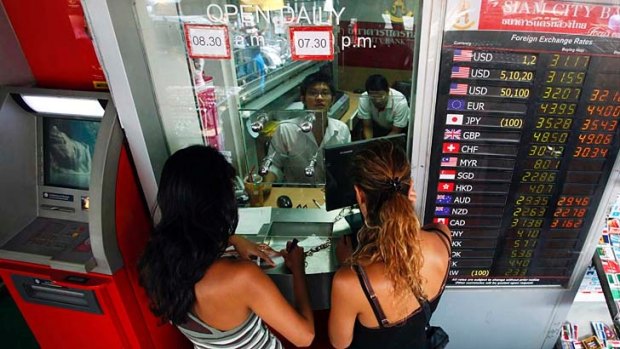This was published 9 years ago
The one question every traveller wants answered: The best way to access money overseas

Bangkok money exchange.
Michael Gebicki, the Tripolgist, has been asked hundreds of questions over the years by Traveller's readers who are seeking advice on their trips. But there's one question he gets asked more than any other and it's this: What is the best, most cost-effective way to access money while overseas? Here's his expert answer.
Don't even think about taking cash. The rate you'll get for your Aussie dollars is worse than if you were withdrawing from an ATM and if you lose it, if your wallet gets snatched or if you're scammed by a money changer, it's gone. One of the few exceptions is Myanmar, where US dollars are the go since ATMs are in short supply, and credit cards are of limited use.
The ATM is the traveller's best friend. Apart from North Korea and the tiny Pacific island of Niue, it's hard to find a country without ATM machines.
Travel money cards are one way to access local currency via an ATM. Several financial institutions offer them under various names but they work the same way. You buy however many US dollars, euros, British pounds or other major currencies you need, which are stored on a card and then withdrawn at foreign ATMs.
I'm not a fan because of the fees associated with travel money cards. Most charge an initial fee, another fee if you top up with more funds, an inactivity fee if you don't use the card for 12 months, an ATM fee for every withdrawal and yet another fee if you return from overseas with unused funds and wish to withdraw whatever remains in Aussie dollars.
Travel money cards are only denominated in major world currencies. If you want to withdraw real in Brazil or baht in Thailand, you'll take a hit - over 8 per cent in the case of one card. Even if you have a card loaded with US dollars and you nip across the border into Canada and make a withdrawal, you'll pay a fee for withdrawing a non pre-loaded currency.
The only potential advantage that a travel money card offers is the value of your Aussie dollar against the pound or euro is locked in at the time you buy. If the Aussie dollar is worth less when you make your withdrawal you're ahead, but the door swings both ways.
A few still cling to travellers cheques but they can be time consuming to change, and they too are available only in major world currencies.
On the upside, if you lose your travellers cheques, they're easily replaced, usually within 24 hours.
If you're an occasional overseas traveller, you probably don't need anything more than your everyday ATM card. You'll pay a currency conversion fee on every transaction, which is between 2-3 per cent, plus whatever the ATM operator decides to charge you. Contact your financial institution to make sure that your card is approved for overseas use, and note that you need a 4-digit pin, a 6-digit pin will not work in many countries.
For more frequent travellers, it might pay to look for a low-fee card and the gold standard is the Citibank Plus Visa Debit Card, which has no fees on overseas transactions. Another hot contender is the Bankwest Zero Platinum MasterCard, which has the same benefits.
Sign up for the Traveller newsletter
The latest travel news, tips and inspiration delivered to your inbox. Sign up now.